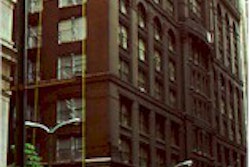The buzz in the MRI market this year will be new superconducting open scanners that manufacturers say offer high-field image quality with the benefits of open magnet design. Vendors hope the new systems will enable providers to meet the needs of claustrophobic patients without compromising image quality.
MRI aficionados will also see new developments in ultra-high-field magnet design, in the 3-tesla range. Originally targeted as research systems, the 3-tesla niche could ultimately become the super-premium end of clinical MRI.
Fonar
Broad market acceptance has been elusive for the company that invented MRI, but Fonar of Melville, NY, has seen several promising developments since RSNA 1999. In August, for example, Fonar signed a marketing agreement with Beijing-based Evergreen Imaging to market Fonar scanners exclusively in China.
Last month the company received FDA 510(k) clearance to market Indomitable, a 0.6-tesla full-body scanner that enables imaging of patients in the weight-bearing state.
First shown at RSNA 1999 as the work-in-progress Stand-Up MRI, the new moniker was imposed during the 510(k) process in order to make the name less generic, according to Daniel Culver, the company's director of communications.
Culver said that while there are other weight-bearing extremity scanners on the market, Indomitable is the only full-body weight-bearing scanner -- unique in its ability to produce high-resolution images of the weight-bearing spine. Indomitable can also be used as a standard full-body scanner, Culver said.
Fonar sold its first Indomitable a week after it received FDA clearance. Under an intellectual property sharing and marketing agreement announced in August, GE Medical Systems will also market Indomitable. The firm will also show the 0.3-tesla Echo and top-of-line 0.6-tesla QUAD 12000 scanners in a characteristically large display area.
Hitachi Medical Systems America
Altaire is a new open superconducting MRI scanner that operates at a field strength of 0.7 tesla and features image quality comparable to a high-field scanner, according to Sheldon Schaffer, vice president and general manager of MR at the Twinsburg, OH, company. Hitachi applied a technology called vertical-field optimized subsystem integration (VOSI) to more closely integrate the different subsystems of the scanner and improve image quality.
Hitachi plans to emphasize the high homogeneity of Altaire’s vertical-field magnet, which features a homogeneity of 0.35 parts per million using the volumetric root mean square (VRMS) method. As a result, the scanner’s 5-gauss line can be contained within the confines of a small room.
Altaire supports advanced imaging applications like single-shot echo-planar imaging, MR angiography with TE values of less than 2 milliseconds, and fast spin-echo imaging with interecho times of 5.8 milliseconds, Schaffer said.
Altaire is already FDA-cleared, and shipments should begin in the first quarter of 2001.
Marconi Medical Systems
Marconi will be highlighting Via 3.0, the newest generation of software for the company’s Eclipse and Polaris high-field scanners. New developments with Via 3.0 include interactive capabilities that allow users to generate several images per second. This can help with patient positioning, and will also be useful for cardiac imaging, where high speeds are necessary, according to Mike Vitagliano, manager of MR marketing at the Cleveland company. Via 3.0 also includes support for new clinical applications such as contrast uptake monitoring for breast imaging applications.
Via 3.0 also enables new clinical applications for Eclipse and Polaris. The company will display a cardiac acquisition and analysis package, as well as a functional MRI package, Vitagliano said. Marconi will show two types of fMRI techniques – a basic package that enables users to develop their own stimulation devices, and a turnkey version that includes stimulation hardware.
In open MRI, Marconi will demonstrate new applications for its Proview scanner. These include diffusion-weighted imaging and a breast coil with biopsy capabilities. Marconi’s iPath 100 and iPath 200 interventional MRI packages will also be demonstrated.
Finally, Marconi will be introducing a brand-new family of MRI scanners that feature an ultra-short bore design to minimize patient discomfort. The new work-in-progress family will include a 3-tesla super-high-field system, as well as a 1.5-tesla model that Marconi believes will push the envelope in terms of magnet openness and performance. The company also plans to display a 0.6-tesla open scanner with high-field performance, Vitagliano said.
Next page:
Millennium through Toshiba



















